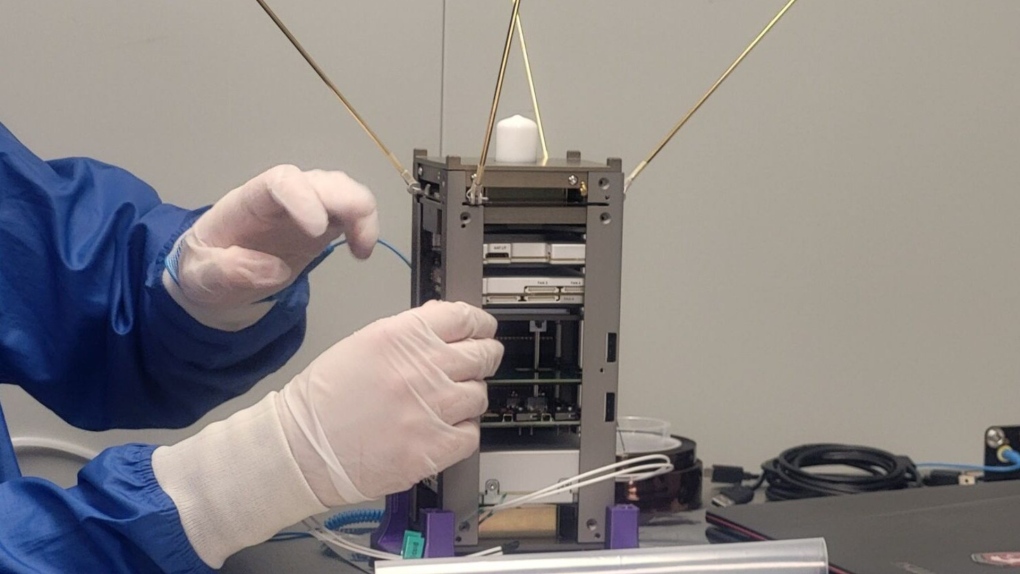An out of this world opportunity: Western students to launch mini satellite aboard SpaceX mission
Constructed by a team at London, Ont.’s Western University, a tiny satellite — roughly the size of a Rubik’s cube — will ride aboard a SpaceX mission bound for the International Space Station.
According to Western University, the first ever miniature satellite built by a team at Western, also known as CubeSat, is set for liftoff from Complex 39A at the Kennedy Space Center in Florida. The launch will provide students the opportunity to learn first-hand about space mission development.
The launch was initially slated for June 3 at 12:34 p.m. but was scrubbed, and is now rescheduled for June 5 at 11:47 a.m.
A ‘CubeSat’ is a cubical mini satellite measuring 10 cm X 10 cm X 10 cm and weighing 1 kg. It can be used alone or in groups, for a maximum of 24 units.
Referred to as “great equalizers” in terms of space exploration and Earth observation, CubeSats are small, modular and relatively inexpensive and easy to launch, according to Western.
Focusing on “delivering equitable opportunities to post-secondary students across the country,” the Canadian CubeSat Project (CCP) was launched by the Canadian Space Agency in 2017.
 Ukpik-1, built by a team at London, Ont.'s Western University, being prepared for launch ahead of its June 2023 launch to the International Space Station. (Source: Western University)
Ukpik-1, built by a team at London, Ont.'s Western University, being prepared for launch ahead of its June 2023 launch to the International Space Station. (Source: Western University)
Led by engineering professor Jayshri Sabarinathan, a team at Western has worked with the Nunavut Arctic College (NAC) since 2018 to develop a CubSat called Ukpik-1 — and it’s this mini satellite that has a one-way ticket to the International Space Station (ISS).
With Monday’s tentative launch date, Ukpik-1 will hitch a ride aboard SpaceX’s Dragon cargo ship CRS-28. Upon arrival at the ISS, the mini satellite will be ejected through an airlock to begin its mission.
“Ukpik-1’s primary goal, which echoes the promise of CCP, is giving students at Western and NAC an out-of-this-world educational opportunity to learn about a space mission development from end to end (conception to operations) while working closely with academic, government and industry partners,” according to Western.
The secondary goal of the mission is to allow students at Western and NAC and faculty the chance to operate an immersive virtual reality camera while in orbit in order to collect various images and data.
CTVNews.ca Top Stories

BREAKING King Charles' cancer treatment progressing well, says Buckingham Palace
King Charles III’s doctors are 'sufficiently pleased' with his cancer treatment and he is expected to return to public-facing duties, Buckingham Palace announced on Friday.
Orca calf that was trapped in B.C. lagoon for weeks swims free
An orca whale calf that has been stranded in a B.C. lagoon for weeks after her pregnant mother died swam out on her own early Friday morning.
'Unacceptable': Trudeau reacts after AFN chief says headdress taken from plane cabin
After the Assembly of First Nations' national chief said her headdress was taken from an airplane cabin this week, Prime Minister Justin Trudeau called the incident 'unacceptable' and a 'mistake' on the part of Air Canada.
Regina police officer injured after being accidentally shot by fellow officer's gun
An investigation is underway after a Regina police officer was accidentally shot by a fellow officer’s gun during the search of a house early Friday morning.
Sophie Gregoire Trudeau on navigating post-political life, co-parenting and freedom
Sophie Gregoire Trudeau says there is 'still so much love' between her and Prime Minister Justin Trudeau, as they navigate their post-separation relationship co-parenting their three children.
DEVELOPING Bird flu outbreaks: WHO weighs in on public health risk
The current overall public health risk posed by the H5N1 bird flu virus is low, the World Health Organization said on Friday, but urged countries to stay alert for cases of animal-to-human transmission.
Taylor Swift dons Montreal designer's dress in 'Fortnight' video
A pair of Montreal designers' work has now been viewed over 41 million times. Taylor Swift dons a Victorian throwback black gown in her latest music video, 'Fortnight', designed by UNTTLD due Simon Belanger and Jose Manuel Saint-Jacques.
From faulty kids' cribs to flammable kids' bathrobes, here are the recalls of the week
Health Canada issued recalls for various items this week, including kids’ bathrobes, cribs and henna cones.
Island near Mull of Kintyre for sale for US$3.1 million
An idyllic 453-acre private island is up for sale off the west coast of Scotland and it comes with sandy beaches, puffins galore, seven houses, a pub, a helipad and a flock of black-faced sheep.





























